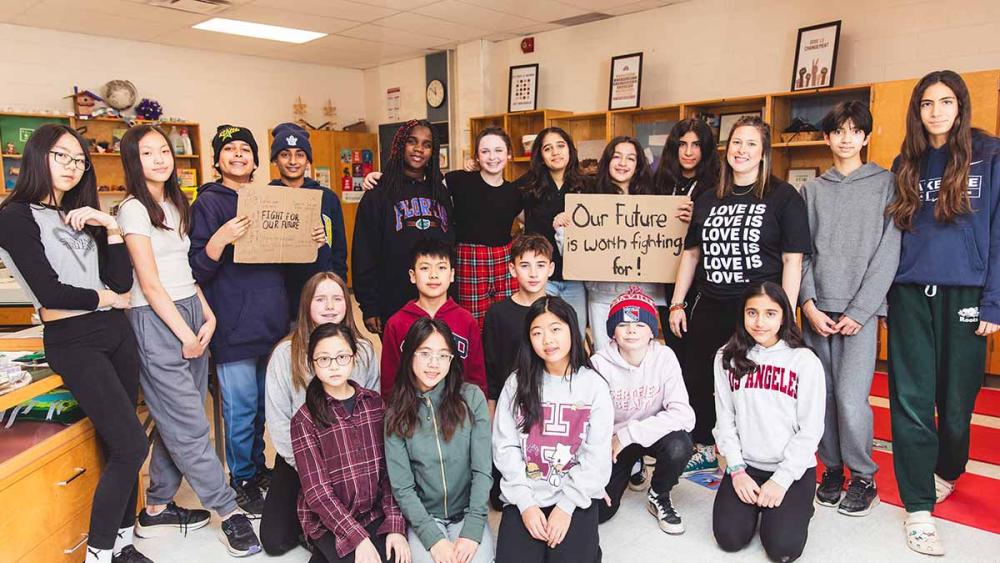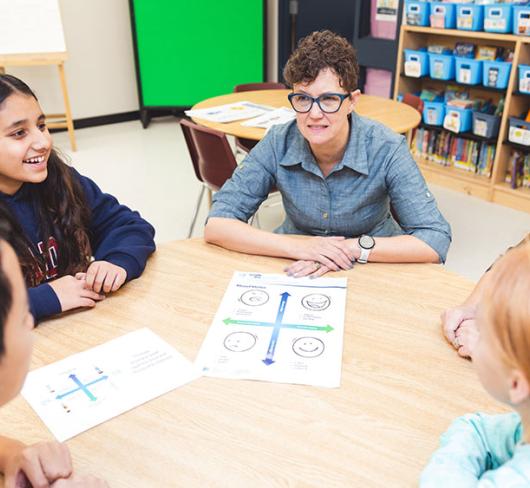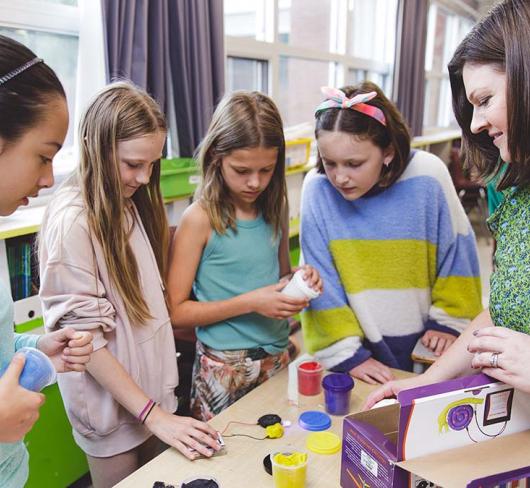
Leading Together for a Sustainable Future
Education plays a critical role in helping societies and economies transition to carbon neutrality and build resilience. Indigenous communities, marginalized populations, and future generations – those who have contributed the least to the climate crisis – will and are feeling the impacts disproportionately. Today, many young people feel overwhelmed by the state of the world they are inheriting. Research shows that nearly 80 per cent of young Canadians aged 16-25 report that climate change negatively affects their mental health.
Young people are calling for education that goes beyond the scientific facts of climate change to focus on solutions-based, hands-on learning. As educators, we have a responsibility to equip the next generation with not only the knowledge but also the agency to address the climate crisis in meaningful ways. It is essential to provide hope, foster resilience, and focus on solutions-based education to counteract the negative mental health impacts of climate change. So, how can educators teach about climate justice while giving students the tools to build a sustainable and equitable future?
Creating a Climate-Centred Classroom
Did you know that quality climate education can have similar carbon-emission reduction effects as large-scale mitigation strategies, such as rooftop solar panels or electric vehicles? Creating a climate-centred classroom requires an integrated, critical, experiential approach that allows youth to practice sustainability and activism. Climate change is often isolated within the science curriculum, sometimes limited to just solitary units despite language regularly cueing us to assess the human impacts on the environment. While understanding the science of climate change, resource use and greenhouse gas emissions is crucial, other subjects also provide valuable opportunities to engage with climate action in meaningful ways.
Practical Strategies for Teaching Climate Justice
Here are a few strategies to help teach climate justice in your classroom:
Strategy 1: Building Context
Use cross-curricular approaches, such as science, social studies and the arts to create a Community Climate Solutions Map that is added to throughout the year. Students can use Google My Maps or a large, printed map to plot locations where climate solutions are being implemented, perhaps as you see them during a neighbourhood walk. Assign groups different categories of solutions and have them research, visit and verify locations before adding them to the map.
WHAT TO TRACK?
- Renewable energy installations – locations of solar panels, wind turbines or geothermal projects
- Green infrastructure – green roofs, rain gardens, permeable pavement or urban tree-planting efforts
- Sustainable transportation – electric vehicle charging stations, bike lanes, public transit hubs
- Waste reduction initiatives – community composting sites, zero-waste stores, recycling drop-off locations
- Climate education & activism – schools with eco clubs, community-led sustainability projects, climate strikes
- Biodiversity & conservation – pollinator gardens, restored wetlands, protected natural areas
Strategy 2:Encouraging Accountable Talk
Engage with questions about equity, access and responsibility. CIVIX is a Canadian nonprofit that offers educational tools to foster civic engagement and critical thinking in students. Their PoliTalks resource aims to help students develop the skills needed for constructive, respectful and critical dialogue, particularly around issues like politics, governance and social responsibility that can be practiced at all ages.
Strategy 3: Learning from Youth Activism
Explore inspiring examples of youth climate activism, such as Cecilia La Rose-Luciuk’s climate lawsuit (See page 8). Have students write their own climate justice demands. This could also be framed as a letter to a policy- maker or a community leader.
Strategy 4: Honouring Indigenous Perspectives
Incorporate voices from Indigenous communities, such as Water Walkers and Grassy Narrows. Explore the Haudenosaunee’s Great Law of Peace and the question of what effect our decisions will have on future generations. Or use the Climate Atlas of Canada, which uses climate data from hundreds of Indigenous communities across Canada to provide insights into local and national climate issues, making it a valuable tool for discussing climate justice.
The Connection Between Education, Sustainability and Mental Health
Environmental education equips students with practical knowledge to combat climate change while helping address the psychological toll of eco-anxiety.
Research highlights the broader benefits of environmental literacy, including:
- encouraging sustainable lifestyles
- strengthening community ties through collective action
- preparing students for careers in the emerging green economy
Eco-anxiety is a real concern for youth today and a growing public health issue, according to the Mental Health Commission of Canada. Many feel anxious, sad and powerless in the face of a rapidly changing world.
Teachers can address eco-anxiety by focusing on solutions and showing students the many ways they can take meaningful action to combat climate change. Solutions-based learning empowers students to make a real impact on the world around them.
Helping Teachers Take the First Step
Integrating sustainability into your classroom doesn’t have to feel overwhelming. Start small – take your next unit or task and explore how you can view it through a sustainability lens. You don’t have to overhaul your entire curriculum overnight. Instead, try asking simple yet meaningful questions:
- How does this topic connect to the Earth?
- How are humans or climate change impacting this topic?
- What real-world solutions can be found to this concept?
- How can I tie in local or global sustainability goals?
- What can I do as an individual, what can we do as a community?
Learning for a Sustainable Future offers a wide range of resources through their Resources 4 Rethinking platform, where you can easily filter by grade, subject and United Nations Sustainable Development Goals. With so many resources available, what small steps might help you integrate a climate lens into your current lessons?
Modeling Active Citizenship
Integrating a climate lens into your teaching isn’t just about lesson plans – it’s also about modeling sustainability in action. As educators, we have a unique opportunity to show students what engaged citizenship looks like. One way to do this is by staying informed about elections and understanding candidates’ platforms, especially on climate action. When students see you taking an interest in solutions, they learn that change happens through everyday actions and decisions.
That doesn’t mean every teacher needs to be the school’s eco leader (though a big shout-out to those who are!). There are many ways to contribute. Climate scientist Katharine Hayhoe suggests that the best way to start conversations about climate change is by connecting it to what you love. Whether it’s a favorite local spot, an outdoor hobby or a community event, exploring how climate change affects those experiences can spark meaningful discussions and action.
Potential Inquiry Questions
- How does the fast fashion industry contribute to climate change and what can consumers do to reduce its impact? Fast fashion produces cheap clothing rapidly, leading to significant waste, water usage and carbon emissions. Students can explore alternatives like sustainable fashion brands, upcycling and buying secondhand. You could even host a sustainable fashion show with reused items.
- How does the production and use of digital devices, like smartphones and computers, contribute to climate change, and what are ways to reduce their environmental impact? The production of electronics involves mining, energy consumption and e-waste. Students can explore the carbon footprint of electronics, e-waste recycling programs and ways to extend the lifespan of devices. You might even organize an e-waste collection drive!
Using Educators' Voices to Amplify Change
Educators have a unique opportunity to advocate for climate action within their spheres of influence – from classroom and community to school boards and their union. Teachers can advocate for their organizations to align student achievement and well-being with climate education goals. Lakehead University’s Climate Leadership within Canadian School Boards: 2023 Review provides recommendations for holding school boards accountable for aligning with the Paris Agreement, specifically the goal to halve greenhouse gas emissions by 2030.
Inquire if Your Board or Union Has:
- declared a climate emergency, like the Upper Grand, Toronto, Halton, Greater Essex County and Rainbow district school boards (this is one way to start holding your employer accountable)
- a climate action plan with specific greenhouse gas reduction targets and climate action initiatives at all levels of governance
- a designated sustainability position or committee responsible for climate action
Educators can take immediate action by joining committees, attending resolution meetings, and drafting letters to school boards or unions to push climate action forward. Even small steps can contribute to a larger shift, one that ensures climate education and action remain at the heart of our schools.
Additional Resources for Teaching Climate Justice
- EcoSchools
EcoSchools empowers communities to adopt sustainability practices, reduce environmental footprints, foster teamwork, and inspire lasting habits, preparing students to lead a greener future. They are developing a platform to use at the board level to support organizational change and compare boards across the country. Imagine the strength of our community if every school was an Ecoschool? - Our World in Data
Interactive charts and data visualizations that help elementary teachers explore climate change and sustainability. The tools make complex topics more accessible and encourage critical thinking, while also tracking global progress on the UN Sustainable Development Goals. - The Solutions Board Game
Inspired by Project Drawdown, this engaging game helps students explore climate change solutions. It presents strategies for reducing carbon emissions in sectors like energy, food and transportation. Through teamwork and critical thinking, students learn how to contribute to a sustainable future. - Sustainable Development Goals (SDGs)
The SDGs offer a global framework for addressing climate change and promoting sustainability. They can be used in the classroom to teach students about the interconnectedness of environmental, social and economic issues, fostering a sense of global responsibility. Want to stay connected to a provincial environmental community of teachers? Join our Locals for a Greener Future WhatsApp community: tinyurl.com/LocalsGreenerFuture.
Sarah Lowes is a member of the Halton Teacher Local.
What Students Say
Rose: We have all the solutions and methods to end climate change, so why don’t we get up and end it. Little things can have big impacts on the world, we might be doing something that can change the entire future of the world right now and not even be noticing it.
Anna: I’ve thought about this world that is growing but perishing all at once. Some skies no longer shine blue, and marshlands are no longer biodiverse. It’s crucial to think about the future. Similar to preparing an important presentation that’s coming up next week, you HAVE to prepare for the climate emergency. It’s not optional anymore.
Khaled: We need to ensure a better future for generations to come. Let’s work together to better the environment. I want future generations to live their lives without having to worry about pollution.

